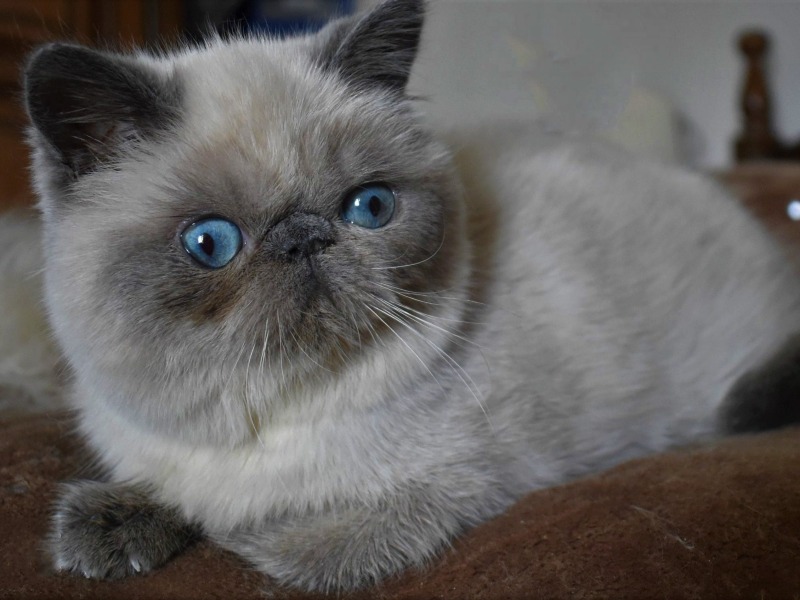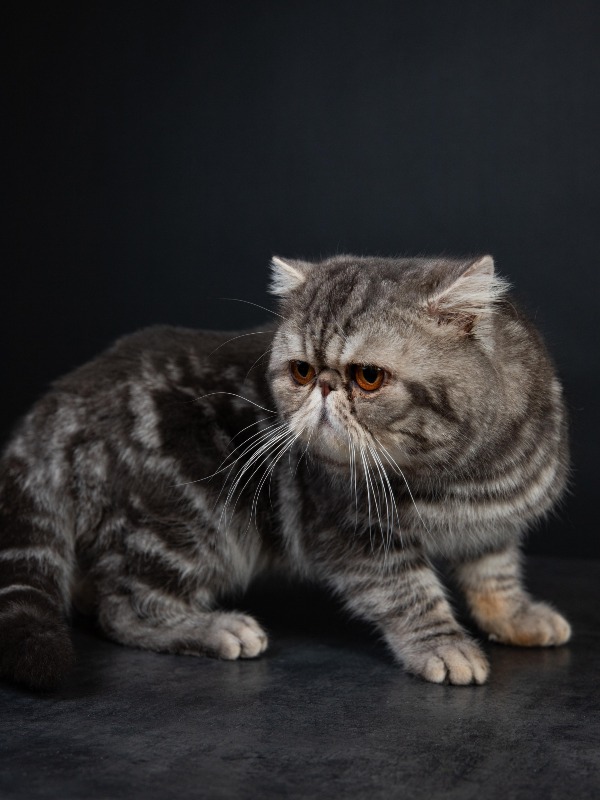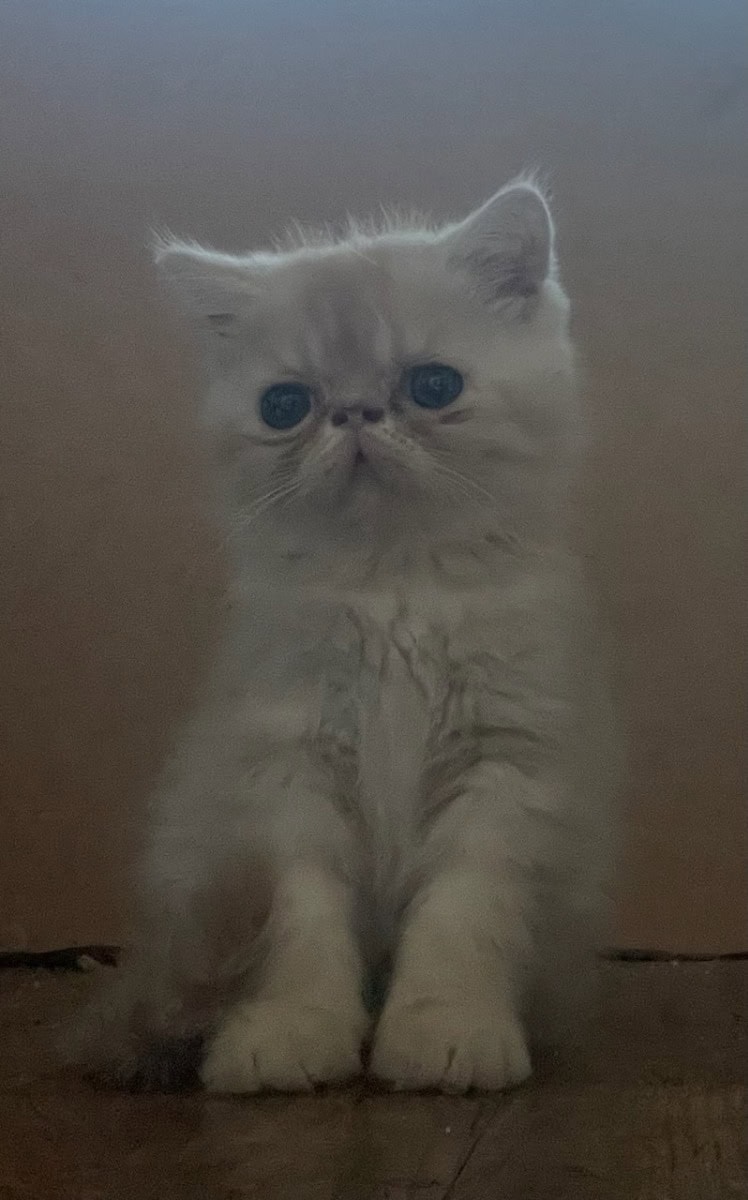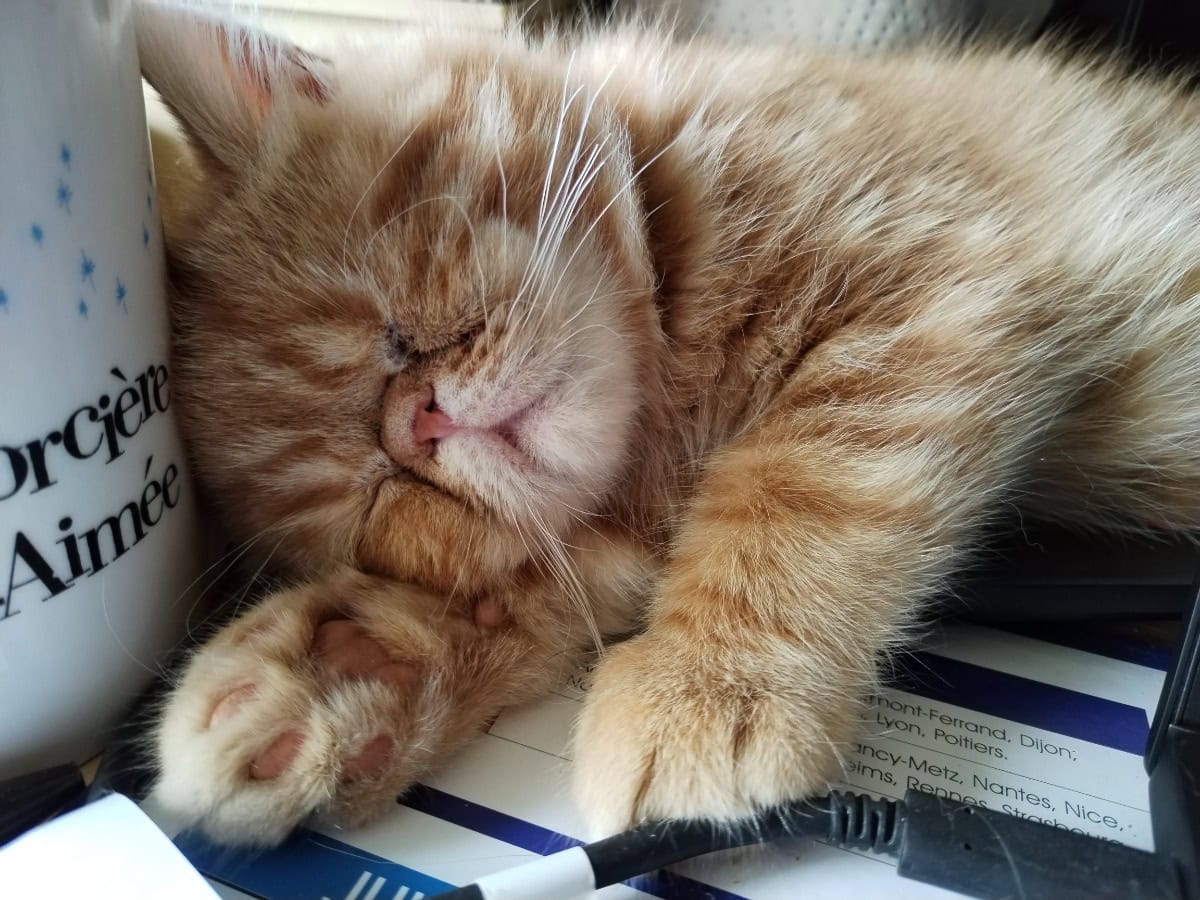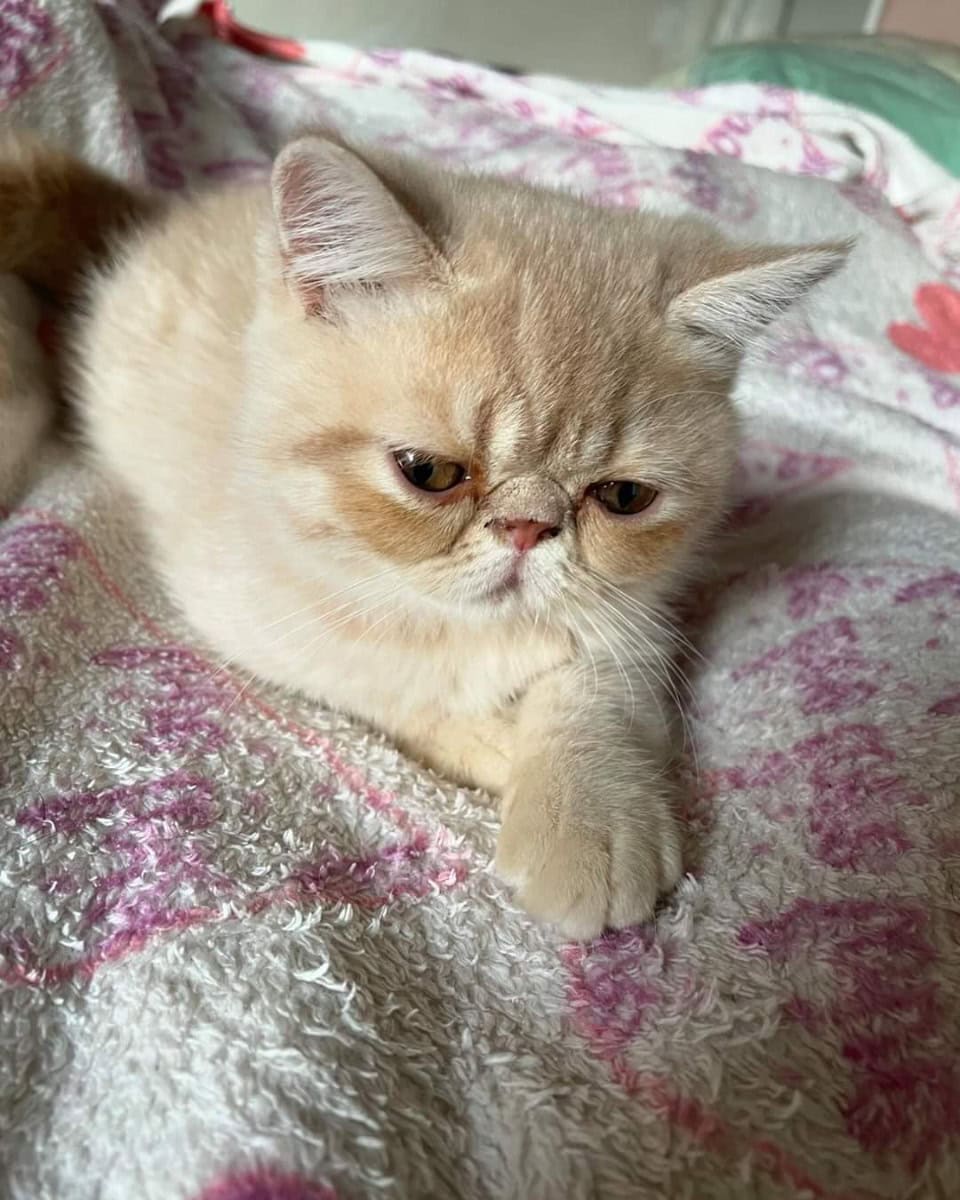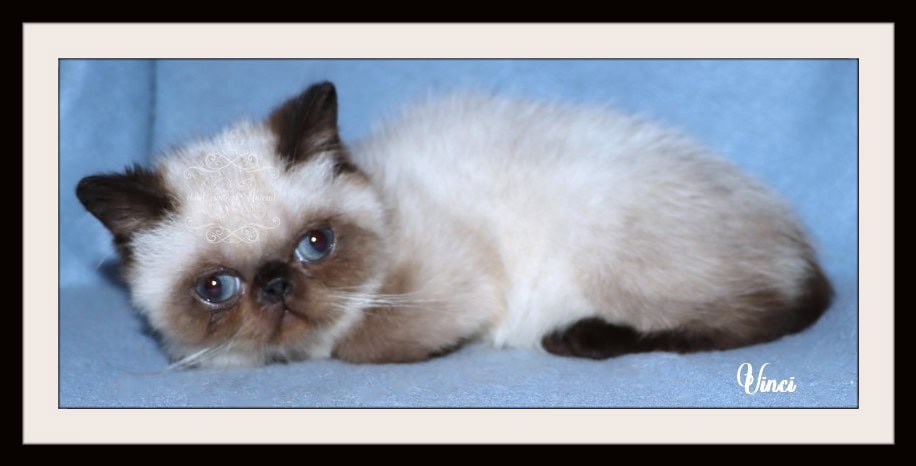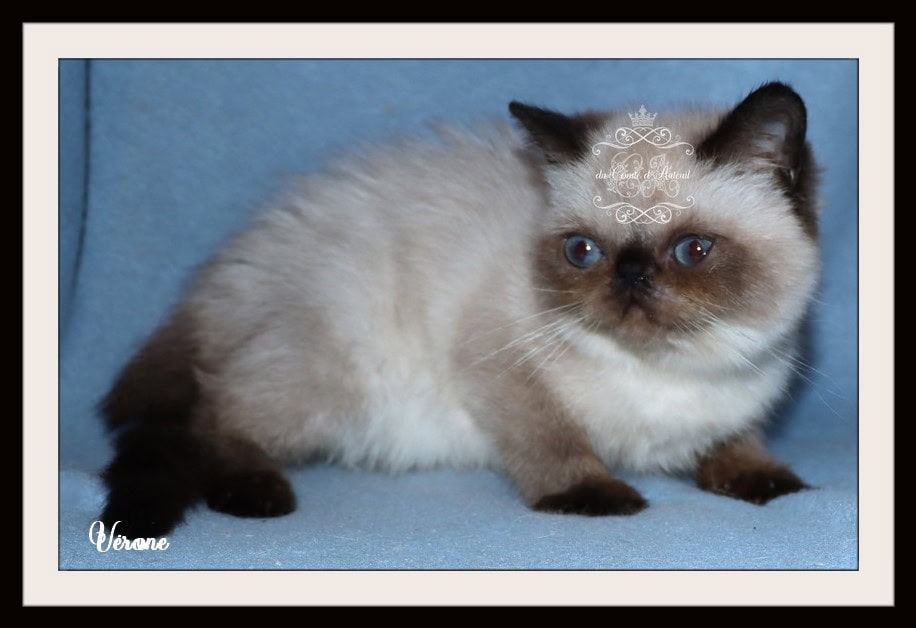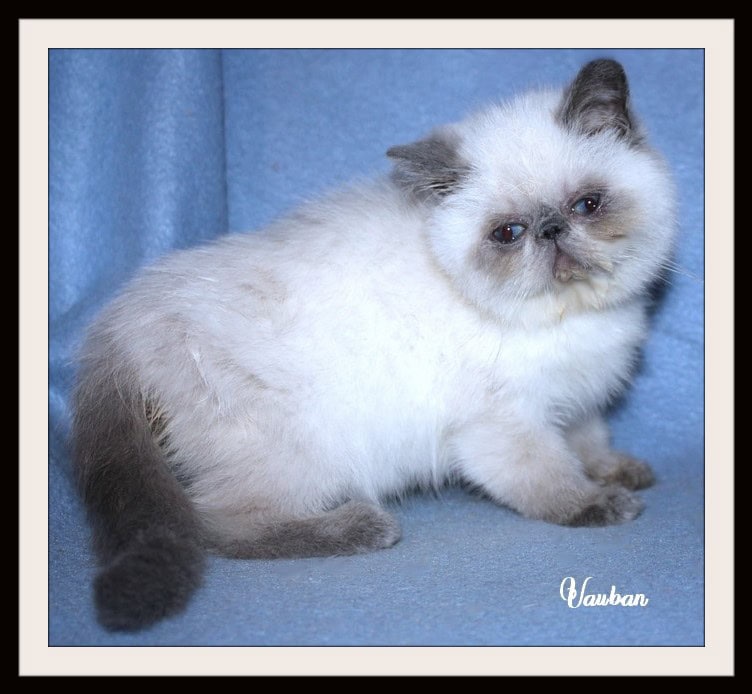Exotic short hair
Autres noms : Exotic cats, Short hair cats
Discover the Exotic Shorthair, a cat with a soft and silky coat, combining the charm of the Persian with the liveliness of the domestic cat. Its affectionate and playful nature makes it an ideal companion for the whole family.
Awareness of acquiring an animal
Adoption and breeding of cats should always be guided by a sincere attachment to the animal and an understanding of its specific needs. Whether for leisure or passion, it is essential to provide a safe, enriching, and suitable environment. Avoid any impulsive acquisition that could harm their well-being. Cats require attention, regular healthcare, and a secure space. Commit to providing them with a quality life by being a conscientious and informed owner or breeder.
To learn more about animal welfare, we invite you to consult our FAQ by clicking the button below:
Origins and history
The Exotic Shorthair is a cat breed that originated in the United States in the 1950s. Its development is the result of a cross between the British Shorthair and the Persian. Breeders aimed to create a cat that possesses the physical characteristics of the Persian, while having a shorter and easier-to-maintain coat.
Over the decades, the Exotic Shorthair has gained popularity, partly due to its distinctive appearance, which combines traits of a round face, large eyes, and a sturdy body. Its dense and plush coat, which does not require the same level of care as that of a Persian, has also won over many cat lovers. The breed has been recognized by most cat associations, further solidifying its status in the show circuit.
In addition to its attractive physique, the Exotic Shorthair stands out for its gentle and affectionate nature. These cats are often described as sociable, curious, and playful, easily adapting to various environments. Their temperament makes them ideal companions for families. Over the years, the Exotic Shorthair has made its mark in the hearts of breeders and owners, becoming a highly appreciated breed worldwide.
Physical characteristics
The Exotic Shorthair is distinguished by its unique appearance and physical characteristics. This cat has a muscular and compact body, showcasing a robust stature that gives it an imposing and elegant look. Its head is wide and round, with full, well-developed cheeks that give it a sweet and affectionate expression.
The eyes of this breed are large, round, and expressive, often in vivid shades ranging from copper to blue, adding to its charm. The nose is short and slightly upturned, which accentuates its flat face. The ears are small and rounded, well-spaced, contributing to the harmony of its face.
Regarding the coat, the Exotic Shorthair has a dense and silky fur that is short and easy to maintain. This coat can come in a variety of colors and patterns, making it a highly appreciated cat among enthusiasts. Its tail is thick at the base and slightly tapers toward the tip, giving it a balanced silhouette. These characteristics make the Exotic Shorthair a companion that is both elegant and endearing.
Character
The Exotic Shorthair is a cat breed that stands out for its appearance and personality. With a compact and robust body, this cat is generally medium to large in size, displaying a muscular build. Its legs are short and strong, often accompanied by well-rounded paws. Its face, round and wide, features prominent cheeks and a short nose, enhancing its adorable and sweet expression.
In terms of temperament, this cat is known for being affectionate and sociable. Its gentle nature makes it particularly appreciated by families and individuals living alone. It frequently seeks companionship from humans and thrives when interacting with them. The Exotic Shorthair is generally calm, but it also enjoys playing, particularly with interactive toys that stimulate its mind.
Furthermore, this cat is renowned for its high intelligence. It can learn quickly and adapts well to different situations, whether in a bustling household or a quieter environment. Its sociable nature makes it an ideal companion, capable of getting along with other pets. In summary, the Exotic Shorthair combines physical beauty with a friendly character, making it an exceptional choice for a companion.
Life expectancy
The Exotic Shorthair, a popular cat breed known for its unique appearance and gentle temperament, typically has a lifespan ranging from 12 to 15 years. That said, some individuals can live beyond this range, reaching up to 20 years with proper care.
The longevity of this breed depends on several factors. First, genetics play a crucial role. Well-bred cats from responsible breeders are often healthier. Regular check-ups at the veterinarian can help detect and treat potential illnesses quickly, thereby contributing to the animal's lifespan.
Additionally, a balanced and appropriate diet, combined with regular physical activity, is vital to maintaining a healthy weight and preventing issues such as obesity, which can reduce lifespan. The living environment is also significant: a safe and stimulating environment helps prevent stress and health complications, thus increasing the chances of a long and happy life.
Finally, emotional well-being is important. A happy and social cat tends to thrive better and live longer. In summary, by offering a suitable living environment, regular veterinary care, and loving attention, it is possible to optimize the longevity of the Exotic Shorthair.
Exercise and activity needs
Exotic Shorthair cats, with their sweet and affectionate temperament, have specific needs regarding exercise and activity. Although they are generally less active than some other cat breeds, it is crucial to provide them with opportunities to move in order to maintain their physical and mental health.
First of all, regular play sessions are essential. Interactive toys, such as feather wands or balls, can pique their interest and encourage them to chase. Tracking games and activities that stimulate their natural instincts help them stay alert and engaged. It is recommended to dedicate at least 20 to 30 minutes a day to fun and dynamic activities to prevent boredom.
Moreover, the living environment plays a key role. Providing spaces where they can climb or explore, such as cat trees or shelves, promotes their agility and well-being. This also gives them the opportunity to expend energy without having to leave their home.
Finally, monitoring their weight is important. Exotic Shorthairs can be prone to obesity due to their calm nature. Therefore, it is essential to combine a balanced diet with regular exercise to ensure a healthy and fulfilling life. By incorporating these elements, you will contribute to their happiness and vitality.
Recommended diet
The diet of Exotic Shorthair cats must be carefully balanced to meet their specific nutritional needs. This breed, appreciated for its dense coat and round face, may be susceptible to certain health concerns. Therefore, a high-quality diet is crucial to prevent obesity and other associated problems.
Proteins should form the foundation of their diet. It is essential to choose foods rich in animal proteins from sources such as chicken, fish, or beef. These proteins support their muscle growth and daily energy levels. Fats should also be present in moderation, as they are necessary for healthy skin and a shiny coat.
Carbohydrates should be limited; prioritize foods containing complex carbohydrates, such as brown rice or vegetables. Fiber is also beneficial for digestion. Ensure that the diet is enriched with vitamins and minerals, such as taurine, which is essential for heart and eye health.
Finally, hydration should not be overlooked. Providing fresh water at all times and possibly incorporating wet food into their diet can help ensure proper hydration. In summary, a well-balanced diet composed of quality proteins and essential nutrients is key to ensuring the health and well-being of cats of this breed.
Training and obedience
Training and educating a purebred cat require a gentle and patient approach, as these animals are known for their affectionate and calm nature. This process starts from a young age, where exposure to various environments, sounds, and social experiences is essential. Early socialization will help them become well-balanced adults, accustomed to interacting with other animals as well as humans.
It is crucial to use positive methods during training, such as positive reinforcement. Treats and praise play a major role in learning desired behaviors. For example, you can teach simple tricks, like sitting or giving a paw, by consistently rewarding the cat each time it follows the command.
Patience is key. Cats can sometimes be disinterested or hesitant to follow instructions. It is important to handle these moments gently and to avoid punitive methods, which could lead to anxiety or distrust towards humans. By establishing a bond of trust, training becomes a moment of shared enjoyment. Finally, creating a stimulating environment with games and toys contributes to good mental and physical balance, thereby promoting successful learning.
Behavior with children
The behavior of Exotic Shorthair cats with children is often marked by a gentle and affectionate nature. These felines tend to form strong bonds with family members, including the youngest ones. Their calm temperament generally makes them patient, which is a great asset during interactions with children who can sometimes be rough.
These cats enjoy play and attention, making them receptive to playful activities suggested by kids. They often like simple games, such as chasing stuffed toys or attacking balls. This not only fosters moments of bonding but also helps to enhance their sociability.
However, it is important to monitor interactions to ensure that the child understands how to treat the animal with gentleness and respect. Although these cats are generally gentle, each individual has its own personality. Therefore, early education for children regarding respecting the animal's boundaries can be beneficial in establishing a harmonious coexistence between the child and the cat.
In summary, these cats can be excellent companions for families, provided that a calm and respectful atmosphere is promoted in their interactions.
Compatibility with Other Animals
Exotic Shorthair cats are generally known for their sociable and gentle temperament, which often makes them compatible with other pets. Their calm and affectionate nature facilitates interactions with other cats and even with dogs. When introducing a new animal into the household, it is essential to do so gradually. Providing a separate space for the newcomer allows the animals to get used to each other's scents and presence.
Establishing a hierarchy and respecting each animal's character is crucial. Although Exotic Shorthairs are peaceful, they can be timid when faced with more intrusive or energetic animals. A well-trained and calm dog can live harmoniously with a cat. However, it is best to avoid homes with predatory animals, as this could stress the cat.
Finally, it is recommended to supervise interactions, especially at the beginning. This helps ensure a safe environment and aids each animal in gradually adapting to their new family dynamic.
Grooming needs
Exotic Shorthair cats are known for their dense and soft fur, making them popular pets due to their attractive appearance. To meet their grooming needs, it is essential to brush them regularly, at least once a week. This action helps prevent tangles and reduces shedding, especially during shedding seasons.
When it comes to maintenance, it is crucial to monitor the hygiene of their eyes and ears. Cats of this breed can have excessive tearing, which may lead to stains on their fur. Therefore, it is recommended to gently clean their eyes with a soft cloth or specific wipes. Regular checks of their ears are also advised to avoid the buildup of wax or other impurities.
Finally, regular nail trimming is essential to prevent injuries, both for the cat and for family members. Careful attention should be paid to their diet and weight, as cats of this breed can be prone to obesity. A proper balance between physical activity and food is vital for their well-being.
Health
The Exotic Shorthair is a breed of cat appreciated for its unique appearance and calm temperament. However, it is important to be aware of certain aspects of its health. The physical characteristics of this breed, particularly its flat face and round eyes, can lead to respiratory issues. Owners should be attentive to signs of respiratory distress, such as snoring or difficulty breathing.
Another common health concern is the predisposition to certain genetic diseases. Exotic Shorthairs can develop hereditary conditions such as polycystic kidney disease, which affects the kidneys. Regular screenings at the veterinarian are therefore essential for early detection of potential hereditary diseases.
Finally, due to their dense fur, these cats require regular grooming to prevent mats and skin irritations. A good lifestyle, a balanced diet, and regular exercise will also help maintain their optimal health and prevent obesity, a common issue in this breed.
Environment and habitat
The Exotic Shorthair is a breed of cat characterized by its short, dense, and silky coat. This cat has a robust morphology with a round face and expressive eyes, giving it a unique and attractive appearance. The ideal environment for an Exotic Shorthair should be comfortable and secure. They appreciate calm and cozy spaces where they can rest and lounge.
Regarding their habitat, this breed adapts well to indoor living, preferably in an urban environment. A space with windows overlooking the outside allows them to observe the world while remaining safe. It is important to provide them with interactive toys to stimulate their curiosity and prevent boredom.
Exotic Shorthairs enjoy spending time with their humans, making them excellent companions. They thrive in families where they receive a lot of affection and attention. Therefore, a balanced, lively yet safe environment is essential for their overall well-being.
Name ideas
Choosing a name for an Exotic Shorthair cat requires considering several factors. First, the name should be easy to pronounce and remember, both for you and your pet. A short and catchy name is often more effective, especially for cats who respond better to high-pitched sounds and short syllables. Next, think about your cat's personality. Observe their behaviors and distinctive traits. A playful cat might inspire a dynamic name, while a calmer cat could deserve a more peaceful one.
The Exotic Shorthair breed is known for its unique appearance and gentle temperament. You can choose names that evoke their origin, their coat, or even fictional characters that resemble them. Here are some suggestions that might fit:
Choco, Moka, Biscuit, Poussin, Lune, Paillettes, Câlin, Zénith, Brume, Kiwi, Lollipop, Tofu, Frimousse, Framboise, Plume.
Feel free to play with the sounds and adapt these suggestions so they perfectly match your cat.
Average purchase price
The Exotic Shorthair is a cat breed prized for its unique appearance and affectionate characteristics. Generally, the purchase prices of a cat of this breed vary based on several factors, including breeding, lineage, and geographical location. On average, the cost of a cat can range between €800 and €3,000.
Cats from champion lineages or those whose ancestors have won awards can be more expensive, reaching up to €3,000. These animals often showcase physical traits that conform to breed standards, making them particularly sought after by breeders and enthusiasts. Additionally, extra costs may be incurred on top of the initial purchase, such as vaccinations, spaying/neutering, or puberty-related expenses.
The choice of breeder is also crucial for the price. A reputable breeder with a good track record for the care and health of their animals may justify higher prices. Conversely, it is essential to ensure that the breeding practices adhere to animal welfare standards. In any case, it is important to consider these aspects before making a purchasing decision.
Expenses
When you become the owner of an Exotic Shorthair cat, it is essential to accurately estimate the monthly expenses related to its care. On average, it is reasonable to budget between 50 and 100 euros per month for food. The nutritional needs of this breed require quality food, often specialized, which can influence the cost.
In terms of veterinary care, you should consider vaccinations, check-up visits, and parasite treatments. On average, these expenses can amount to around 15 to 30 euros per month if you spread the cost of annual visits throughout the year.
Grooming fees can also vary, but budgeting about 20 to 30 euros monthly can be wise to maintain the health of the coat and prevent dermatological issues. Additionally, it is advisable to budget around 10 euros per month for miscellaneous supplies, such as bedding or toys.
Finally, don’t forget to account for potential pet health insurance, which can represent an additional cost of 20 to 40 euros per month. In summary, it is prudent to plan a total budget of 115 to 230 euros per month to ensure the well-being of your companion.
Destination and usage
The Exotic Shorthair is a highly sought-after breed of cat as a pet, valued for its affectionate nature and gentle personality. This breed is often chosen by families because of its calm temperament and sociability. Exotic Shorthairs get along well with children and can live harmoniously with other pets, making them an ideal choice for many households.
In terms of companionship, these cats are often appreciated for their comforting presence. Their affectionate nature drives them to seek the company of their owners, fostering a strong bond between the animal and human. They are often loyal companions who enjoy curling up on laps or lounging near their humans. Additionally, their relatively easy maintenance, thanks to their short coat, makes them low-maintenance pets.
Finally, Exotic Shorthairs contribute to the emotional well-being of their owners. Their playful behavior and natural curiosity bring joy and amusement to daily life. Thus, this breed is an excellent option for those seeking a loyal, gentle companion that brings warmth and happiness into a home.
Legislation and regulation
The legislation and regulations concerning the Exotic Shorthair cat breed vary significantly from country to country. In many Western countries, such as the United States and Canada, there are generally no specific restrictions on the ownership or breeding of this breed. The laws focus more on animal welfare, pet health, and breeding conditions, ensuring that cats are raised in appropriate environments.
In Europe, regulations can differ from one country to another. Some countries, like the United Kingdom, have strict standards regarding ethical breeding, including requirements for animal health and welfare. Breeders often have to prove that they meet these standards before they can register their cats. Other European countries, for example in the Balkans, may not have such strict regulations, sometimes leading to less ethical breeding practices.
In some Asian countries, the popularity of cats may lead to an increase in demand. This can result in unregulated or illegal breeding practices, jeopardizing the health of the animals. Therefore, awareness of animal rights and responsible breeding practices is crucial for the future of this breed.
Finally, animal protection organizations worldwide encourage animal welfare standards, which indirectly influence regulations around the globe. The evolution of these laws should aim to ensure the health and happiness of cats while preserving the breed with integrity.
Official recognition
The Exotic Shorthair is a breed of cat that was developed in the United States. It has been officially recognized in many countries, including those in Europe, North America, and Asia. This breed is distinguished by its round appearance and short, dense coat, which has been influenced by the Persian breed. In fact, its recognition primarily came about thanks to established feline clubs that appreciated its gentle and friendly temperament.
In the United States, the Exotic Shorthair received recognition from feline organizations such as the American Cat Fanciers Association and the Cat Fanciers' Association. These organizations have established breed standards that highlight the desired physical and behavioral traits. In Europe, several national federations, like the International Cat Federation, have also included this breed in their official classifications, promoting its ethical breeding.
In other regions, such as Asia, recognition can vary, but several countries, like Japan and South Korea, are showing increasing interest in this breed. Local clubs organize shows and competitions, thus contributing to its popularity and official recognition. In summary, the Exotic Shorthair is widely accepted and appreciated in the cat world, reflecting its universal appeal.
Pedigrees
To obtain a pedigree or an equivalent for Exotic Shorthair cats, there are several recognized breed registries and clubs. These organizations are dedicated to the breeding, promotion, and preservation of the breed standards. They also play an essential role in tracking lineages and authenticating purebred cats.
Among the main clubs is the **Fédération Internationale Féline** (FIFe), which provides a strict framework for breed registration and pedigree issuance. Breeders must adhere to high standards regarding health, genetics, and ethical breeding to be members. Similarly, the **Cat Fanciers' Association** (CFA) is recognized for its role in summarizing pedigrees and regulating cat shows. This club also promotes education and information regarding proper cat care.
Other organizations, such as **The International Cat Association** (TICA), are also dedicated to the registration and preservation of breeds. By choosing a breeder registered with these clubs, buyers can ensure the provenance of their cat and obtain a valid pedigree, which is essential for participating in shows or for breeding. Therefore, it is crucial to research these organizations to guarantee the quality and traceability of Exotic Shorthair cats.
Prohibitions
Cat breeds, including the Exotic Shorthair, may be subject to varying regulations depending on the country, influenced by concerns about animal health and welfare. In some regions, laws may prohibit the breeding of specific breeds deemed susceptible to genetic health issues related to their appearance. This type of legislation often aims to protect companion animals from suffering caused by extreme physical characteristics.
Additionally, some animal protection organizations advocate for bans on the sale of inbred breeds, arguing that this encourages traits that could harm the animals' health. Such initiatives can have a direct impact on the availability of the Exotic Shorthair in certain markets.
Furthermore, laws regarding the import and export of certain breeds can also vary. In some countries, restrictions may exist to protect local biodiversity or to prevent the spread of diseases. These legislative complexities make the situation for cat breeds, including the Exotic Shorthair, particularly variable on a global scale.
Breeders of Exotic short hair
Want to see more breeders of Exotic short hair?
Check out the page of our directory listing all breeders of Exotic short hairClassified Ads of Exotic short hair
Want to see more ads of Exotic short hair?
Check out the page listing all the ads of Exotic short hairBreed clubs of exotic short hair
No of exotic short hair breed clubs are currently registered on Preeders.
If you would like to highlight your breed club, sign up for free now and be the first to appear on this page.

